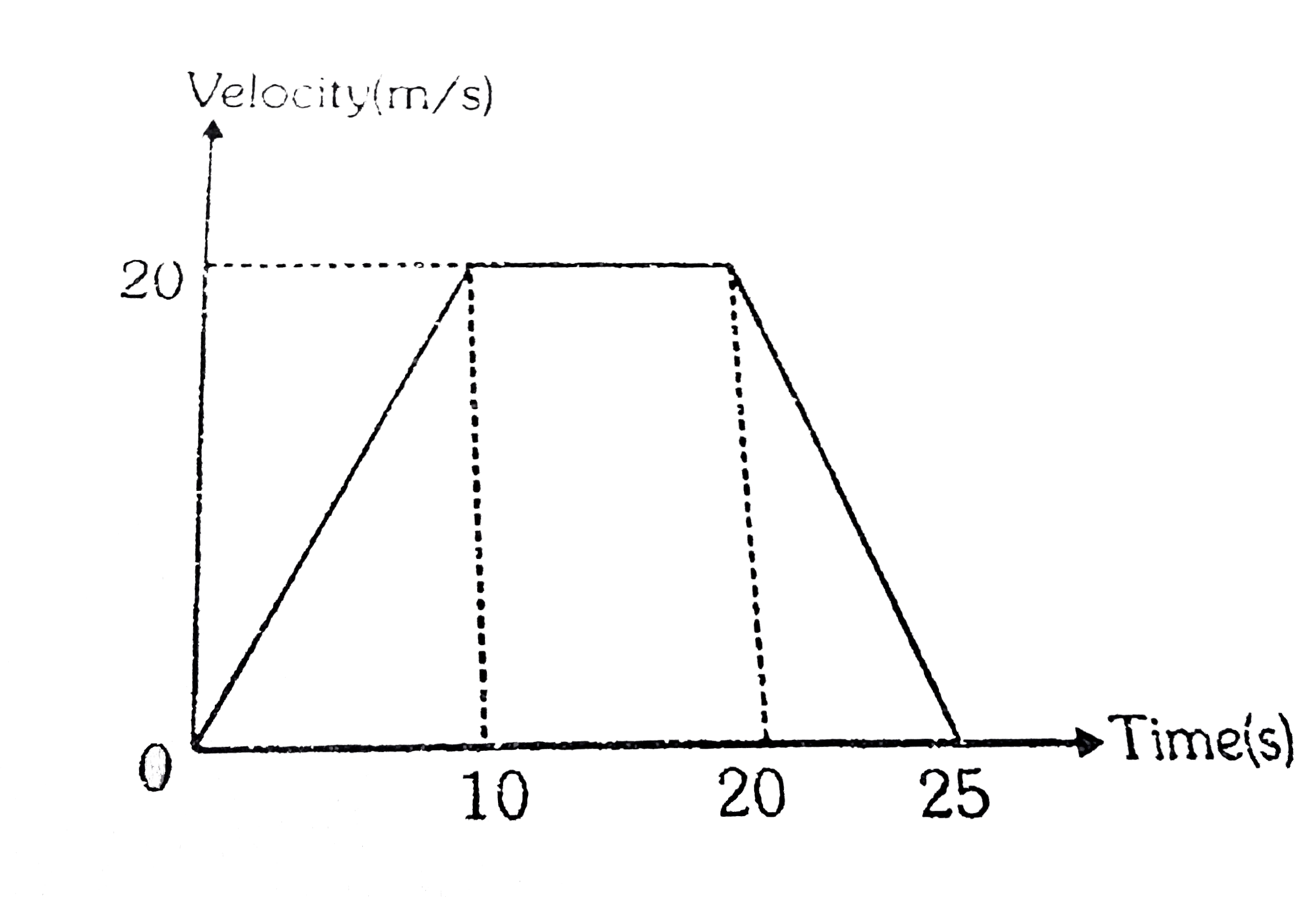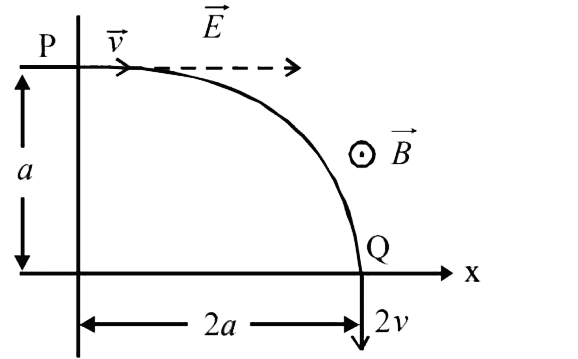A toy car with charge q moves on a frictionless horizontal plane surface under the influence of a uniform electric field →E. Due to the force q→E, its velocity increases from 0 to 6m/s in one second duration. At that instant the direction of field is reversed.
The car continues to move for two more seconds under the influence of this field. The average velocity and the average speed of the toy car between 0 to 3 seconds are respectively.
1m/s3.5m/s
1m/s,3m/s
2m/s,4m/s
1.5m/s,3m/s
The correct Answer is:B
To solve the problem step by step, we will analyze the motion of the toy car in three distinct time intervals: from 0 to 1 second, from 1 to 2 seconds, and from 2 to 3 seconds.
Step 1: Analyze the motion from 0 to 1 second
- Initial velocity (u): 0 m/s (the car starts from rest)
- Final velocity (v): 6 m/s (after 1 second)
- Time (t): 1 second
Using the formula for acceleration:
a=v−ut=6−01=6m/s2
Now, we can calculate the distance traveled (s1) during this interval using the formula:
s=ut+12at2
Substituting the values:
s1=0⋅1+12⋅6⋅(1)2=3m
Step 2: Analyze the motion from 1 to 2 seconds
- Initial velocity (u): 6 m/s (the velocity at the end of the first second)
- Final velocity (v): To find this, we need to calculate the effect of the reversed electric field.
- Time (t): 1 second
Since the electric field is reversed, the acceleration will be negative. The acceleration (a) is equal to -6 m/s² (the same magnitude but opposite direction).
Using the formula for final velocity:
v=u+at=6+(−6)⋅1=0m/s
Now, we can calculate the distance traveled (s2) during this interval:
s2=ut+12at2=6⋅1+12⋅(−6)⋅(1)2=6−3=3m
Step 3: Analyze the motion from 2 to 3 seconds
- Initial velocity (u): 0 m/s (the velocity at the end of the second second)
- Final velocity (v): To find this, we again consider the reversed field.
- Time (t): 1 second
The acceleration remains -6 m/s².
Using the formula for final velocity:
v=u+at=0+(−6)⋅1=−6m/s
Now, we can calculate the distance traveled (s3) during this interval:
s3=ut+12at2=0⋅1+12⋅(−6)⋅(1)2=−3m
Step 4: Calculate total distance and displacement
- Total distance traveled:
Total distance=s1+|s2|+|s3|=3+3+3=9m
- Total displacement:
Displacement=s1+s2+s3=3+3−3=3m
Step 5: Calculate average velocity and average speed
- Average speed:
Average speed=Total distanceTotal time=9m3s=3m/s
- Average velocity:
Average velocity=DisplacementTotal time=3m3s=1m/s
Final Answer:
- Average velocity: 1 m/s
- Average speed: 3 m/s
- Initial velocity (u): 0 m/s (the car starts from rest)
- Final velocity (v): 6 m/s (after 1 second)
- Time (t): 1 second
a=v−ut=6−01=6m/s2
s=ut+12at2
Substituting the values:
s1=0⋅1+12⋅6⋅(1)2=3m
- Initial velocity (u): 6 m/s (the velocity at the end of the first second)
- Final velocity (v): To find this, we need to calculate the effect of the reversed electric field.
- Time (t): 1 second
v=u+at=6+(−6)⋅1=0m/s
s2=ut+12at2=6⋅1+12⋅(−6)⋅(1)2=6−3=3m
- Initial velocity (u): 0 m/s (the velocity at the end of the second second)
- Final velocity (v): To find this, we again consider the reversed field.
- Time (t): 1 second
v=u+at=0+(−6)⋅1=−6m/s
s3=ut+12at2=0⋅1+12⋅(−6)⋅(1)2=−3m
- Total distance traveled:
Total distance=s1+|s2|+|s3|=3+3+3=9m
Displacement=s1+s2+s3=3+3−3=3m
- Average speed:
Average speed=Total distanceTotal time=9m3s=3m/s
Average velocity=DisplacementTotal time=3m3s=1m/s
- Average velocity: 1 m/s
- Average speed: 3 m/s
Topper's Solved these Questions
- SOLVD PAPERS 2017 NEET, AIIMS & JIPMERBOOK - DC PANDEY ENGLISHCHAPTER - SOLVD PAPERS 2017 NEET, AIIMS & JIPMEREXERCISE - Solved paper 2018(AIIMS)
28 Videos
- SOLVD PAPERS 2017 NEET, AIIMS & JIPMERBOOK - DC PANDEY ENGLISHCHAPTER - SOLVD PAPERS 2017 NEET, AIIMS & JIPMEREXERCISE - Solved paper 2018(JIPMER)
38 Videos
- SOLVD PAPERS 2017 NEET, AIIMS & JIPMERBOOK - DC PANDEY ENGLISHCHAPTER - SOLVD PAPERS 2017 NEET, AIIMS & JIPMEREXERCISE - Solved Papers 2017(JIPMER)
28 Videos
- SIMPLE HARMONIC MOTIONBOOK - DC PANDEY ENGLISHCHAPTER - SIMPLE HARMONIC MOTIONEXERCISE - Integer type questions
14 Videos
- SOUND WAVESBOOK - DC PANDEY ENGLISHCHAPTER - SOUND WAVESEXERCISE - Exercise 19.7
4 Videos
Similar Questions
The phenomenon of splitting of spectral lines under the influence of the electric field is known as
View SolutionUniform electric and magnetic fields are produced in the same direction. An electron moves in such a way that its velocity remains in the direction of electric field. The electron will-
View Solution
Knowledge Check
Movement of dispersion medium under the influence of electric field is known as
AelectrodialysisBelectrophoresisCElectroosmosisDcataphoresisA particle of mass m and charge q has and initial velocity →v=υ0ˆj. If an electric field →E=→–––(0)ˆi and magnetic field →B=B0ˆi act on the particle, its speed will double after a time :
At=2mv0qE0Bt=2B0qmv0Ct=√3B0qmv0Dt=√3mv0qE0
An electron having charge 'e' and mass 'm' is moving a uniform electric field E. Its acceleration will be
View SolutionThe velocity-time graph of a car moving along a straight road is shown in figure. The average velocity of the car is first 25 seconds is

View SolutionA particle of charge q and mass m starts moving from the origin under the action of an electric field →E=E0ˆiand→B=B0ˆi with a velocity →v=v0ˆj. The speed of the particle will become 2v0 after a time.
View SolutionA particle of mass m and charge q has and initial velocity →v=υ0ˆj. If an electric field →E=→–––(0)ˆi and magnetic field →B=B0ˆi act on the particle, its speed will double after a time :
View SolutionA particle of charge +q and mass m moving under the influence of a uniform electric field Eˆi and uniform magnetic field Bˆk follows a trajectory from P→Q as shown in fig. The velocities at PandQ are vˆi and −2vˆj . which of the following statement(s) is/are correct ?

View SolutionA particle having charge q moves with a velocity v through a region in which both an electric field →E and a magnetic field B are present. The force on the particle is
View Solution
